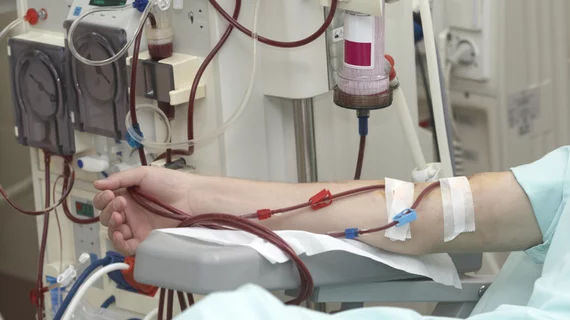Deaths from MI, stroke and pulmonary embolism are down among kidney patients receiving dialysis
Mortality rates from myocardial infarction (MI), stroke and pulmonary embolism (PE) improved from 1998 to 2015 among patients receiving dialysis, according to new findings published in JAMA Network Open.[1] In fact, mortality rates are dropping faster among those patients than patients in the general population.
“Patients receiving dialysis are at increased risk of MI, stroke and pulmonary embolism,” wrote lead author Gurbey Ocak, MD, PhD, with the department of internal medicine at St. Antonius Hospital in the Netherlands, and colleagues. “However, it is unknown to what extent they benefited from the improvements in the prevention and management of the aforementioned diseases when compared with the general population. From a clinical perspective, it is important to know whether advances in the prevention and clinical treatment strategies have resulted in improved outcomes among patients receiving dialysis. It is possible that patients receiving dialysis have not achieved significant benefit from these improvements because therapies could be ineffective or underused in this patient group.”
Ocak et al. tracked data from more than 220,000 patients who received dialysis in one of 11 European countries from 1998 to 2015. All data came from one of 16 registries focused on kidney patients. The median patient age was 68 years old, and 62.8% were male. The median follow-up time was 2.4 years. This patient population was then compared with the general population of the same 11 European countries.
Overall, the group found, 38.1% of patients receiving dialysis died during follow-up. MI was the cause of death for 9.1% of patients, stroke was the cause of death for 6% and pulmonary embolism was the cause of death for 0.5%. In the general population, meanwhile, the causes of death during the study period were 7.5% for MI, 6.1% for stroke and 0.5% for pulmonary embolism.
In both the dialysis and general population groups, MI, stroke and pulmonary embolism were associated with fewer patient deaths as time went on. This difference was more pronounced, however, among the patients who underwent dialysis than it was among patients in the general population.
“There are several potential reasons for the decreasing mortality rate ratios due to MI, stroke, and pulmonary embolism in patients receiving dialysis compared with the general population,” the authors wrote. “In the last decades, many improvements have been made in the prevention and management of MI (eg, the use of antiplatelet drugs, including clopidogrel, prasugrel, and ticagrelor; β-blockers; renin-angiotensin system inhibitors; statins; and implantable cardioverter defibrillators), stroke (eg, the use of dipyridamole, clopidogrel, carotid endarterectomy, and statins), and pulmonary embolism (eg, the use of vena cava filters, low-molecular-weight heparin use for patients who are hospitalized, and the use of computed tomography angiography). A reason may be that recent advances in the prevention and management of these disorders are more beneficial for patients receiving dialysis than in the general population.”
The team also pointed to the development and introduction of new dialysis quality measures, more standardized dialysis processes and improvements in the care of patients with chronic kidney disease as potential reasons for these observed improvements.
The study’s authors did emphasize, however, that patients receiving dialysis still face a greater risk of certain cardiac complications, including MI, than patients in the general population.
“Prevention and management schemes that are effective in the general population could not be beneficial for patients receiving dialysis,” they wrote. “Therefore, in our opinion, future studies should focus on tailored therapy for patients receiving dialysis rather than on implementing prevention and treatment schemes that are recommended for the general population.”
Related Acute Coronary Syndromes Content:
Is PCI without stenting safe for low-risk STEMI patients?
VIDEO: Vaccines boosted survival among STEMI patients with COVID-19
PCI vs. CABG for left main disease: Key takeaways from a new meta-analysis
Cardiology groups debut new heart failure guidelines ahead of ACC.22
Depression linked to a higher stroke risk among heart attack survivors
Reference:

